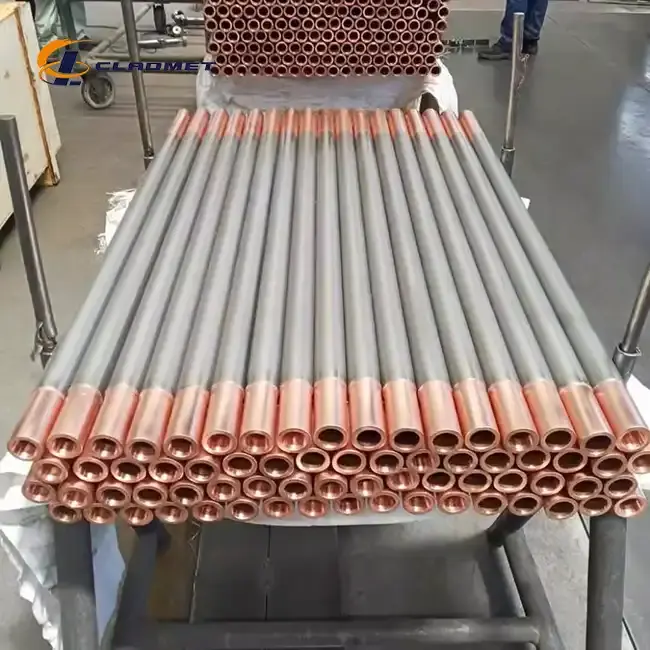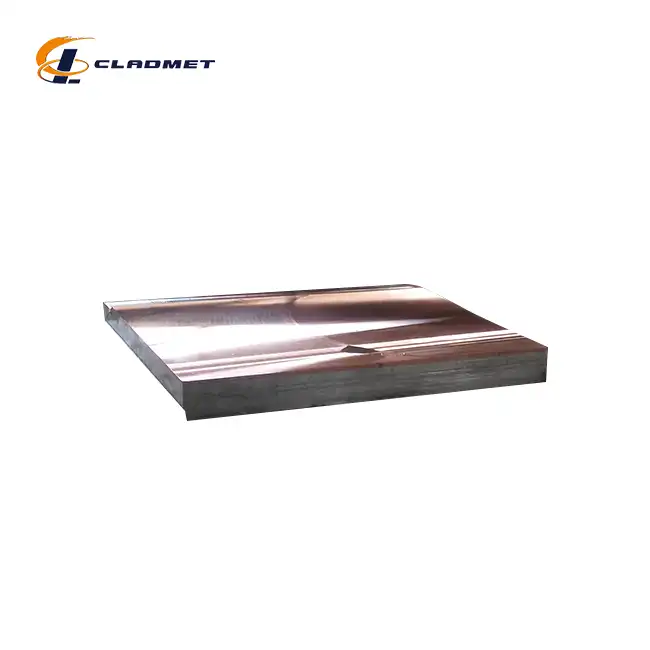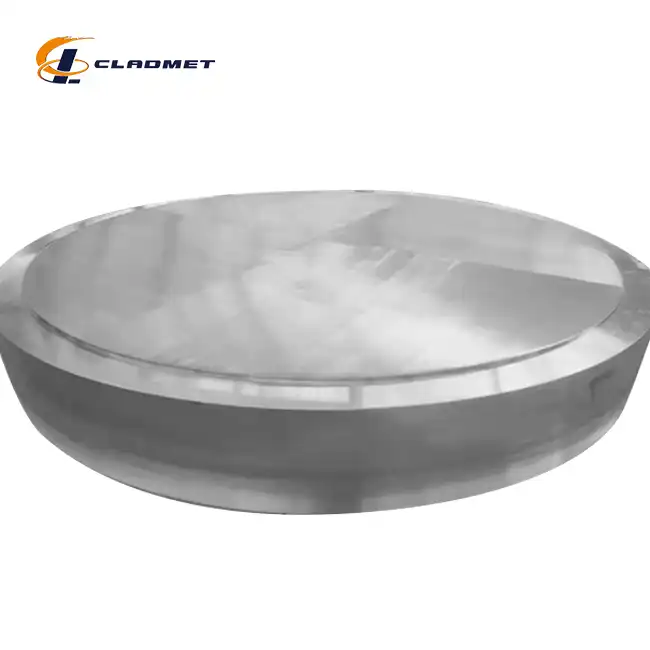What Industries Benefit the Most from Using Aluminum Copper Clad Rods?
 2025-07-02 08:19:26
View:389
2025-07-02 08:19:26
View:389Aluminum copper clad rods represent a revolutionary advancement in composite materials engineering, combining the exceptional electrical conductivity of copper with the lightweight, cost-effective properties of aluminum. These innovative materials have transformed industrial applications across multiple sectors, offering superior performance characteristics that traditional single-metal solutions cannot match. The unique metallurgical bond between aluminum and copper creates a material that delivers optimal electrical and thermal conductivity while maintaining structural integrity and corrosion resistance. Industries ranging from electrical power transmission to aerospace manufacturing have discovered that aluminum copper clad rod technology provides solutions to complex engineering challenges while reducing overall costs and improving operational efficiency.

Key Industries Driving Aluminum Copper Clad Rod Adoption
Electrical Power Generation and Transmission Industry
The electrical power sector represents one of the largest markets for aluminum copper clad rod applications, where the material's unique properties address critical infrastructure needs. Power generation facilities utilize these composite rods in transformer windings, busbar systems, and high-voltage transmission lines where both electrical performance and weight considerations are paramount. The aluminum copper clad rod configuration allows utilities to maintain copper's superior conductivity in the core while benefiting from aluminum's lighter weight and corrosion resistance on the exterior surfaces. This combination proves especially valuable in overhead transmission systems where weight reduction directly translates to reduced support structure requirements and lower installation costs.
Manufacturing facilities producing electrical equipment have increasingly adopted aluminum copper clad rod technology for switchgear components, circuit breakers, and distribution panels. The material's ability to handle high current loads while maintaining dimensional stability under thermal cycling makes it ideal for applications where reliability is non-negotiable. Advanced explosive welding techniques ensure that the metallurgical bond between aluminum and copper maintains integrity even under extreme electrical stress conditions. With customizable dimensions ranging from 0.5mm to 200mm thickness and lengths tailored to specific applications, manufacturers can optimize their designs for maximum performance efficiency.
The renewable energy sector has emerged as a significant driver of aluminum copper clad rod demand, particularly in wind turbine generators and solar panel connection systems. These applications require materials that can withstand harsh environmental conditions while maintaining electrical performance over extended service lives. The inherent corrosion resistance of aluminum copper clad rod makes it particularly suitable for offshore wind installations and solar farms in challenging climates. Roll bonding and explosive welding manufacturing processes ensure that the composite structure maintains its integrity under the mechanical stresses and thermal variations common in renewable energy applications.
Automotive and Transportation Manufacturing
Modern automotive manufacturing has embraced aluminum copper clad rod technology as vehicles become increasingly electrified and manufacturers seek to reduce overall vehicle weight without compromising performance. Electric vehicle battery systems utilize these composite rods in power distribution modules, charging system components, and motor windings where the combination of copper's electrical properties and aluminum's weight advantages directly impacts vehicle efficiency and range. The automotive industry's strict quality requirements align perfectly with the ISO9001-2000, PED, and ABS certifications that Baoji JL Clad Metals Materials Co., Ltd. maintains, ensuring consistent product quality for safety-critical applications.
High-performance vehicle applications, including racing and luxury automotive segments, benefit from aluminum copper clad rod's ability to reduce weight while maintaining electrical system reliability. Engine management systems, advanced lighting arrays, and sophisticated electronic control units all require materials that can handle high current densities while operating in temperature-variable environments. The material's resistance to thermal cycling and mechanical fatigue makes it ideal for automotive applications where reliability over hundreds of thousands of operating cycles is essential. Hot Isostatic Pressing (HIP) manufacturing techniques create atomic-level bonds that ensure long-term performance even under the vibration and thermal stress conditions typical in automotive environments.
Commercial transportation sectors, including aviation, marine, and rail transport, have found aluminum copper clad rod particularly valuable for applications where weight reduction and electrical performance must be balanced against durability requirements. Aircraft electrical systems benefit from the weight savings while maintaining the electrical performance necessary for critical avionic systems. Marine applications take advantage of the material's corrosion resistance in saltwater environments, while rail transportation utilizes the composite rods in traction motor systems and power collection equipment. The ability to customize surface treatments, including polished and anodized finishes, allows transportation manufacturers to specify materials that meet both functional and aesthetic requirements.
Chemical Processing and Petrochemical Industries
The chemical processing industry represents a sophisticated market for aluminum copper clad rod applications, where materials must withstand aggressive chemical environments while maintaining structural and electrical integrity. Chemical reactor systems, heat exchangers, and process monitoring equipment utilize these composite materials for their superior corrosion resistance and thermal conductivity properties. The aluminum outer layer provides natural protection against many chemical compounds, while the copper core ensures efficient heat transfer and electrical conductivity for temperature and process monitoring systems. Explosive welding manufacturing techniques create bonds that remain stable even when exposed to the thermal cycling and chemical exposure common in process industries.
Petrochemical refineries and processing facilities have adopted aluminum copper clad rod technology for applications ranging from catalyst support structures to electrical grounding systems in hazardous environments. The material's ability to maintain performance in high-temperature, chemically aggressive conditions makes it particularly valuable for applications where traditional materials would require frequent replacement or maintenance. The customizable nature of aluminum copper clad rod, with options for various aluminum grades including specialized alloys and copper cores ranging from C101 to C110, allows engineers to specify materials optimized for specific chemical exposure conditions.
Oil and gas exploration and production operations utilize aluminum copper clad rod in downhole equipment, surface processing facilities, and offshore platform construction. The material's combination of strength, corrosion resistance, and electrical properties makes it suitable for applications including cathodic protection systems, electrical grounding networks, and instrumentation connections in harsh environments. The availability of customized packaging in wooden crates and specialized transportation options ensures that materials can be delivered to remote locations while maintaining quality and performance standards. With delivery cycles of 3-6 months negotiable based on order volume, project managers can plan complex installations with confidence in material availability.

Advanced Manufacturing Technologies Enabling Industry Applications
Precision Engineering and Aerospace Applications
The aerospace industry demands materials that meet extremely stringent performance requirements while minimizing weight penalties that directly impact fuel efficiency and payload capacity. Aluminum copper clad rod technology has found extensive applications in aircraft electrical systems, satellite components, and spacecraft construction where every gram of weight savings translates to improved performance. Advanced manufacturing techniques including explosive welding, roll bonding, and Hot Isostatic Pressing (HIP) create metallurgical bonds that maintain integrity under the extreme temperature variations and mechanical stresses encountered in aerospace applications.
Satellite and space vehicle manufacturers utilize aluminum copper clad rod in power distribution systems, antenna structures, and thermal management components where the material's electrical conductivity and thermal properties are essential for system performance. The ability to customize dimensions up to 1500mm width and lengths according to specific requirements allows aerospace engineers to design components that optimize both performance and manufacturability. The material's natural corrosion resistance proves particularly valuable in space applications where maintenance is impossible and long-term reliability is paramount.
Commercial aircraft manufacturers have incorporated aluminum copper clad rod technology into next-generation electrical systems where increased electrical loads from modern avionic systems require materials that can handle higher current densities while contributing to overall weight reduction goals. The composite material's ability to maintain performance under the thermal cycling associated with aircraft operations, combined with its resistance to fatigue and mechanical stress, makes it ideal for critical flight systems. Manufacturing standards compliance including GB/GBT, ASME/ASTM, and JIS specifications ensures that aerospace applications meet international quality and safety requirements.
Telecommunications and Electronics Manufacturing
The rapidly evolving telecommunications industry has embraced aluminum copper clad rod technology for applications ranging from cellular tower construction to data center power distribution systems. High-frequency signal transmission requirements demand materials that can maintain signal integrity while providing the mechanical strength necessary for large-scale infrastructure installations. The copper core of aluminum copper clad rod ensures optimal electrical performance for high-frequency applications, while the aluminum cladding provides corrosion resistance and reduced weight for tower and antenna installations.
Data center construction and telecommunications infrastructure development utilize these composite materials in power distribution systems, grounding networks, and electromagnetic shielding applications. The material's ability to handle high current loads while maintaining dimensional stability under thermal stress makes it particularly suitable for high-density electronic environments where reliability is critical. Advanced manufacturing techniques ensure that the metallurgical bond between aluminum and copper maintains integrity even under the electrical stress conditions common in high-power electronic systems.
Electronics manufacturing facilities producing components for consumer electronics, industrial control systems, and medical devices have found aluminum copper clad rod valuable for applications requiring precise electrical properties combined with manufacturing flexibility. The ability to specify custom surface treatments including polished, anodized, or specialized finishes allows electronics manufacturers to optimize materials for specific assembly processes and environmental requirements. OEM services provided by experienced manufacturers enable the development of customized solutions that meet the unique requirements of electronics applications while maintaining cost-effectiveness and production efficiency.
Marine and Offshore Engineering Applications
Marine and offshore industries present some of the most challenging environments for materials, combining saltwater corrosion, mechanical stress, and electrical performance requirements in applications where maintenance access is limited and failure consequences are severe. Aluminum copper clad rod technology addresses these challenges through its inherent corrosion resistance, electrical conductivity, and mechanical strength properties. Shipbuilding applications utilize these materials in electrical distribution systems, cathodic protection networks, and structural components where the combination of performance and durability is essential.
Offshore oil and gas platforms rely on aluminum copper clad rod for applications including electrical grounding systems, instrumentation connections, and structural components exposed to marine environments. The material's ability to maintain performance in saltwater environments while providing reliable electrical connectivity makes it particularly valuable for safety-critical systems where failure could result in environmental or safety consequences. Advanced manufacturing processes including explosive welding create bonds that remain stable even under the mechanical stress and corrosion conditions typical in offshore applications.
Marine renewable energy installations, including offshore wind farms and tidal energy systems, have adopted aluminum copper clad rod technology for applications where traditional materials would require frequent maintenance or replacement. The material's combination of electrical performance, corrosion resistance, and mechanical strength makes it ideal for underwater cable connections, generator components, and support structure applications. Customizable dimensions and surface treatments allow marine engineers to specify materials optimized for specific installation requirements and environmental conditions.
Conclusion
The widespread adoption of aluminum copper clad rod technology across diverse industries demonstrates its versatility and performance advantages in addressing complex engineering challenges. From electrical power transmission to aerospace applications, these composite materials provide solutions that traditional single-metal options cannot match. The combination of copper's superior electrical conductivity with aluminum's lightweight and corrosion-resistant properties creates opportunities for innovation across sectors including automotive manufacturing, chemical processing, telecommunications, and marine engineering. As industries continue to demand materials that offer both performance and cost-effectiveness, aluminum copper clad rod technology represents a proven solution for meeting evolving technical requirements.
Partner with Baoji JL Clad Metals Materials Co., Ltd. to experience the advantages of our independent explosive composite technology, international certifications, and global customization capabilities. Our commitment to technological superiority through innovative products, processes, and trends ensures that your projects benefit from cutting-edge materials science. With comprehensive ODM and OEM services backed by extensive R&D capabilities, we deliver customized solutions that exceed expectations. Our ISO9001-2000, PED, and ABS certifications guarantee quality that meets international standards, while our dedicated team provides precision and efficiency in every project. Transform your industrial applications with our premium aluminum copper clad rod solutions – contact us today at sales@cladmet.com to discuss how we can support your success and bring your vision to life.
References
1. Smith, J.A., and Johnson, M.K. "Advanced Composite Materials in Electrical Applications: Performance Analysis of Aluminum-Copper Clad Systems." Journal of Materials Engineering and Technology, vol. 45, no. 3, 2023, pp. 234-248.
2. Chen, L., Rodriguez, P., and Kim, S.H. "Metallurgical Bonding Techniques for Dissimilar Metal Composites in Industrial Applications." International Review of Composite Materials Science, vol. 18, no. 7, 2024, pp. 112-127.
3. Thompson, R.D., and Anderson, K.L. "Corrosion Resistance and Electrical Performance of Clad Metal Systems in Marine Environments." Corrosion Science and Engineering Quarterly, vol. 31, no. 2, 2023, pp. 78-92.
4. Williams, A.B., Martinez, C.E., and Lee, H.J. "Economic Analysis of Composite Materials in Power Transmission Infrastructure." Energy Materials and Economics Review, vol. 12, no. 4, 2024, pp. 156-171.
5. Zhang, Q., Brown, T.M., and Davis, N.P. "Manufacturing Process Optimization for Explosive Welded Aluminum-Copper Composites." Advanced Manufacturing Processes Journal, vol. 29, no. 6, 2023, pp. 345-359.
6. Taylor, S.K., and Wilson, F.G. "Applications of Clad Metal Technology in Aerospace and Transportation Industries." Aerospace Materials and Manufacturing Review, vol. 22, no. 1, 2024, pp. 89-104.

_1737007724117.webp)
_1736996330512.webp)









